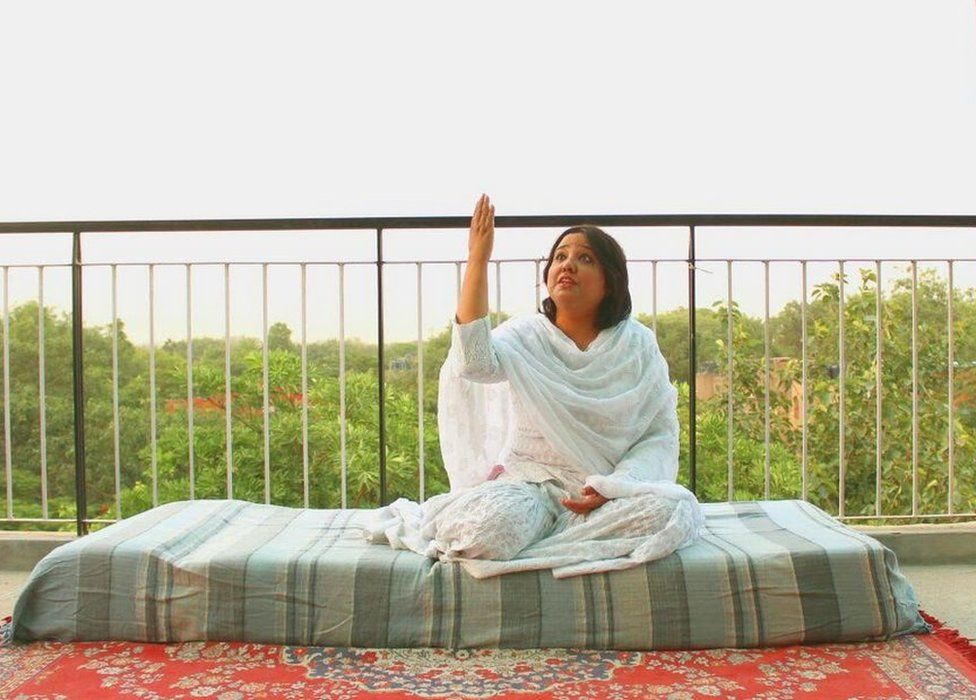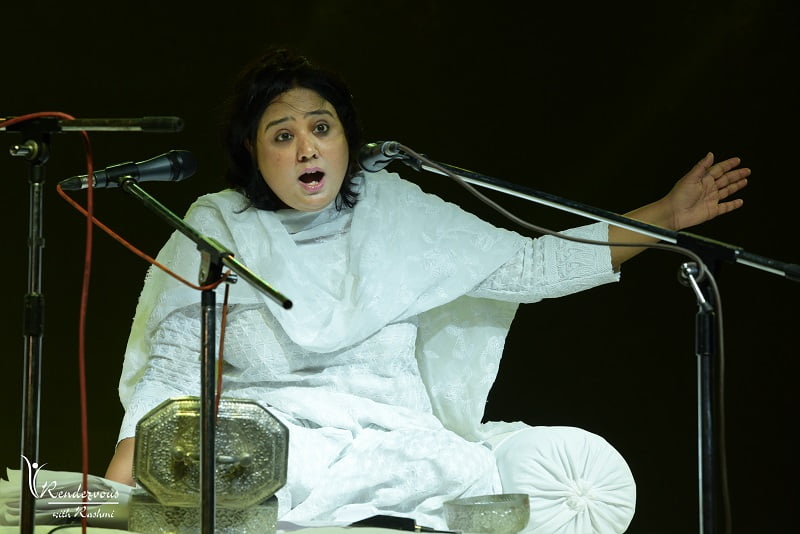I remember the first time I watched a Dastangoi performance. Being a history student hailing from Lucknow, I was familiar to the art, conceptually. It was at an academic fest organised by my college department that I got the opportunity to witness it. I can still recall the auditorium reverberating with the strong voice of the performer, and the claps of appreciation.
My interest in gender studies prompted me to further investigate the art with an objective to know more about female Dastango performers. That is how I discovered Fouzia Dastango, the first female Dastango performer who has pursued the art and has quietly broken glass ceilings with her artistic will.
A Dastangoi performance does not require much – a Dastango with a strong command over language and a minimal set capable of adapting to the performance spaces ranging from theatres to auditoriums and rallies. The only ornament is the voice of the performer who carries the audience along through tales of enchantment
Dastangoi: The charming art of storytelling
Dastangoi is a 13th century form of Urdu oral storytelling with roots in Pre-Islamic Arabia. The word is an amalgamation of the Persian words, ‘Dastan’ and ‘Goi’ which means ‘story’ and ‘tell’ respectively. It found its way into the Indian subcontinent during the Mughal era and reached its zenith in the 19th century. The art form also found audience in the streets of Lucknow where it was warmly welcomed during those days. However, after the 19th century, this oral storytelling tradition became redundant. The last known Dastango was Mir Baqar Ali after whose demise, the form died a gradual death.
It was only in 2005 that this long-lost art was revived by the Urdu poet Shamsur Rahman Faruqi along with writer Mahmood Faruqi. Since then, this mesmerising tradition of fantasy, mythology, epics and other worlds created through stories has managed to re-carve its lost identity. The most fascinating thing about Dastangoi is that it anchors itself on the voice of the Dastango (story teller)- who takes you into a portal of stories for the entire duration of the performance, which is usually forty minutes.
A Dastangoi performance does not require much – a Dastango with a strong command over language and a minimal set capable of adapting to the performance spaces ranging from theatres to auditoriums and rallies. The only ornament is the voice of the performer who carries the audience along through tales of enchantment.
Fouzia: The first female Dastango
Fouzia was born into a lower middle-class family in Old Delhi. She struggled to keep her life together and started offering tuitions right from her seventh grade to contribute to the family income. Her family ensured that she continued her studies. Fouzia earned a Bachelor’s Degree in Sociology from Jamia Millia Islamia and later on, a Master’s in Education Planning and Administration. Before joining the tradition of Dastangoi, she was a lecturer at the State Council of Educational Research & Training (SCERT).
Fouzia was introduced to Dastangoi when she went to watch a performance in 2006. The dastan was performed by Mohammad Faruqi and Danish Hussain. In an interview with Museum Culture Marketing, she said that she “felt at home” during the performance. She instantly knew this was what she wanted to do. The advantage of having studied in an Urdu medium school, along with a flair for storytelling gradually became her strengths in this traditional art form. But Fouzia also knew that she was treading down a road never traveled by women and that she would have to face multiple challenges.

Fouzia began her training under Mohammad Faruqi and performed her first Dastangoi in 2006. However, she had to overcome several gender stereotypes to perform on stage. For instance, in an interview with Your Story, she recalls how she “didn’t wear the hijab or the burka, so people were surprised initially.” She performed while also managing her job as a lecturer till 2014, after which she quit to become a full time Dastangoi performer.
Also read: Maha Laqa Chanda: The First Female Published Urdu Poet Of The Indian Subcontinent
Fouzia stepped into a profession which was entirely masculine and stood her ground firmly. She exclaims “I didn’t have any one to guide me, or someone I could look up to and follow in their footsteps.” She was entering a terrain extremely unfamiliar to her, and she remembers how she “did not have a godfather” to further promote her in this genre. She faced initial setbacks because none of her her family members were acquainted to theatre or performing arts. She reminisces- “I struggled to adjust myself and understand the rules and regulations of this world. Whatever I had to do, I had to do it myself. I have fallen down, picked myself up and learnt things through trial and error.” Nevertheless, she successfully carved a niche for herself in this domain, having performed more than 200 Dastangois all across the country.
Among the myriad of things she emphasises upon, mental health and feminism are the most poignant. She has performed stories of the famed feminist writer Ismat Chughtai including Nanhi ki Naani
Fouzia and her dastans: Highlighting social issues through storytelling
Fouzia got into the world of storytelling because she was in love with literature, especially the treasure trove of Urdu literature. Fouzia grew up listening to stories from her maternal and paternal grandmothers and her mother in their ‘Kharkhandaari zabaan’ which now forms a very integral part of her performances. Over time, she focused on narrating stories which had a social message. She aims to focus on the issues faced by women during the partition of 1947. One can often find her narrating Manto’s partition stories.
Among the myriad of things she emphasizes upon, mental health and feminism are the most poignant. She has performed stories of the famed feminist writer Ismat Chughtai including Nanhi ki Naani. Keeping the queer community in mind, she performed a Dastangoi revolving around the story Kallo by Samina Nazer. Fouzia’s focus is also to ensure the preservation of the Begamati zabaan of Old Delhi– a language of and by women, said to have originated during the Purdah system.
Pandemic and storytelling: The real-virtual dilemma
For an art form that relies on the enthusiasm of the audience as much as it does on the voice of the Dastango, the Covid 19 pandemic has affected it hard. The shift of live performances from theatres to virtual platforms has been challenging for the form. “Dastangoi is a live art form, the world of Dastangoi is not a camera and mic off task”, Fouzia states while addressing the difficulties brought forth by the pandemic.

Fouzia has many successful and ongoing podcasts to her name, and has collaborated with Radio Red FM to bring us Dastan – e-Bollywood. She believes the audio platform has a better reach and caters to her monetary needs as an artist in these challenging times. The episodes in Dastan-e-Bollywood focus on the lives and times of the much loved yesteryear actors Madhubala and Meena Kumari. Fouzia had always been a determined decision maker and has steadily ventured into the online space with her art to adapt to the new normal.
Art for entertainment and social dialogue: Fouzia’s Dastangoi legacy
Dastangoi is predominantly performed in Urdu, which is why it is even more important to preserve, protect and pass this tradition to the younger generations. After Hindi gradually came to be the dominant language of many states, the prominence of Urdu has declined and there has generally also been dissonance in the politics of language in the mainstream. This is exactly why the preservation and the protection of this art form that has its roots in the 16th Century is necessary.
Also read: 5 Urdu Stories That Explore The Plight Of Women In Marriages
Fouzia believes that it in order toensure this, it is important to sensitise children to the spirit of listening to stories and letting their imagination run wild. She works closely with Indian National Trust for Art and Cultural Heritage (INTECH) to further this purpose. She received the “Tagore Veteran Artist Award” from the Aseem Asha Foundation for her efforts to keep Dastangoi alive,. She is also recognized as India’s First Woman Dastangoi Artiste by the Ministry of Women and Child Development. Apart from this, she finds mention in “First Ladies”, a list of 112 women achievers, for her remarkable contributions.
Dastangoi is a beautiful form of story narration which breathes history, politics, culture, and tradition with every living Dastango and their performances. Pieces like Dastan e Mahabharat, Dastan e Gandhi, Dastan e Radha Krishnan (all in Urdu), are examples of the refined train of thought that goes behind every script produced. Fouzia’s voice and her unparalleled charm in reinterpreting stories to give political messages is an example of how art can be used as an effective tool for both entertainment and social dialogue.
Featured Image Source: Fouziadastango.com
About the author(s)
Srishti is a first year Masters student in Gender Studies at AUD. She is passionate about reading and chasing after dogs. You will often find her recommending ASMR videos to people.




